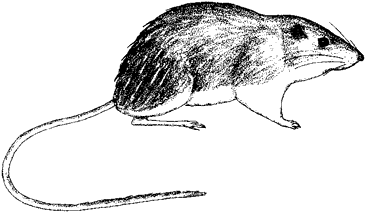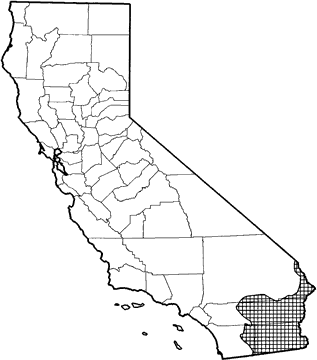
Spiny Pocket Mouse
Distribution, Abundance, and Seasonality
Two forms occur in California. C. s. rufescens occurs in rough terrain and narrow washes in hills south from Palm Springs to the border of Mexico (Riverside and San Diego cos.). C. s. spinatus inhabits the southeastern corner of the state on rocky slopes vegetated by desert scrub (Grinnell 1933), from Needles south along the Colorado River Valley to the border of Mexico. Few reports of this species can be found. It seems to prefer sparsely covered desert scrub habitats on stony soils and rocky washes. The elevational range is from 45-900 m (150-3000 ft).

Range Map
Specific Habitat Requirements
Feeding: Seeds of forbs, grasses, and shrubs are collected from rocky slopes.
Cover: Burrows are dug, probably at the bases of shrubs.
Reproduction: Young are born in burrow chambers, probably in nests of dried grasses.
Water: Water is obtained metabolically from seeds and green vegetation.
Pattern: Frequents desert scrub on rocky mesas, hills, and desert washes.
Species Life History
Activity Patterns: No data found. Probably active year-round. Nocturnal.
Seasonal Movements / Migration: None.
Home Range: No data found.
Territory: No data found.
Reproduction: Litters of 4-6 probably are born from April to June. Gestation is 3-4 wk, and recently weaned young may breed.
Niche: Predators include owls, coyotes, badgers, and snakes. Competitors for food resources include other desert rodents and ants.
Comments: Like other closely related pocket mice (e.g., C. baileyi and C. penicillatus), C. spinatus inhabits extremely xeric habitats of southern California. Seeds are stored in the burrow and elsewhere.
Sources & References
California Department of Fish and Game, 1999.
California's Wildlife, Sacramento, CA.
Written by: P. Brylski, reviewed by: H. Shellhammer, edited by: R. Duke
Grinnell, J. 1933. Review of the recent mammal fauna of California. Univ. Calif. Publ. Zool. 40:71-234.
Miller, A. H., and R. C. Stebbins. 1964. The lives of desert animals in Joshua Tree National Monument. Univ. California Press, Berkeley. 452pp.
California Animal Facts | California's Wildlife